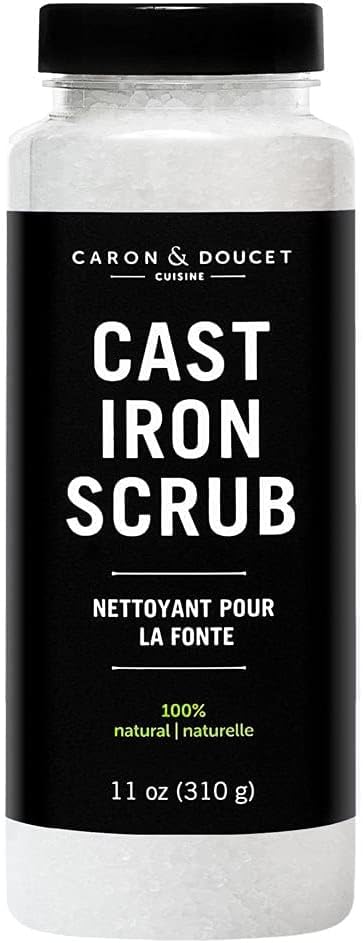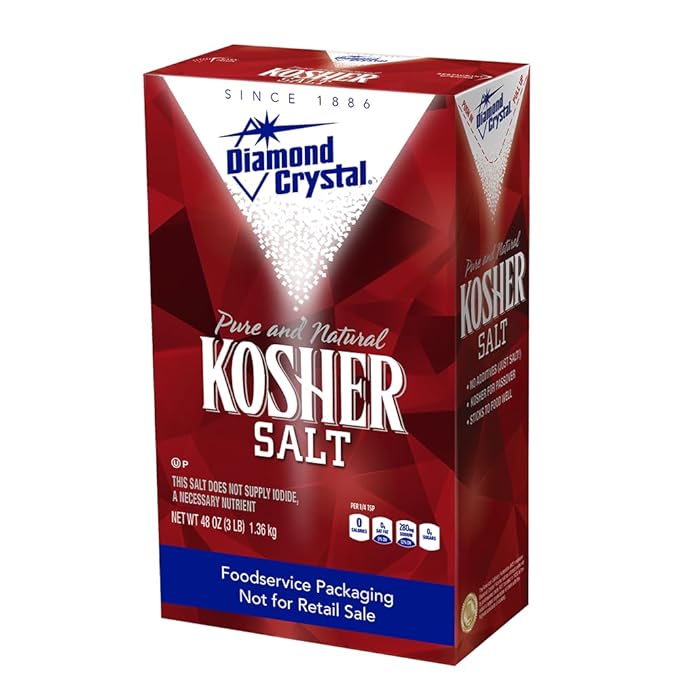<- Return to the ultimate cast iron skillet guide
If you’re a fan of cast iron cookware like I am, then you know how important it is to take care of it properly. Cast iron is durable, versatile, and can last a lifetime—but only if you know how to clean cast iron after cooking correctly. A well-maintained cast iron pan can make everything from crispy bacon to perfectly seared steaks, but improper cleaning can strip the seasoning, cause rust, or even ruin your pan.
In this article, I’ll walk you through how to clean cast iron after cooking, including different tools and methods like using kosher salt, chainmail scrubbers, steel wool, and when soap is and isn’t appropriate to use.
Why Proper Cleaning Matters
Before we dive into the methods, it’s important to understand why knowing how to clean cast iron after cooking is essential. Cast iron pans are unique because they develop a non-stick surface called “seasoning” through repeated use with oils and fats. Seasoning not only prevents food from sticking but also protects the pan from rust. Cleaning cast iron improperly can strip away this protective layer, leaving the pan vulnerable to rust and reducing its effectiveness.
By following the right cleaning methods, you can maintain the seasoning and prolong the life of your cast iron cookware.
How to Clean Cast Iron After Cooking: The Basics
After cooking, the first step is always to let the pan cool down a bit before starting the cleaning process. Cleaning it while it’s still warm (but not hot) helps remove stuck-on food more easily. Here’s a simple, step-by-step approach to cleaning your cast iron skillet after cooking:
1. Remove Food Scraps
First, wipe the skillet down with a paper towel or cloth to remove excess food or grease. If there are stubborn food bits left behind, don’t worry—we’ll tackle that next.
2. Rinse with Hot Water
In most cases, hot water is your best friend when cleaning cast iron. Simply run hot water over the pan while using a scrubber or sponge to lift off food debris. I find that using a stiff brush or non-abrasive sponge works best for this step. Avoid using cold water, as the sudden temperature change can cause the cast iron to warp.
3. Dry the Pan Thoroughly
After rinsing, it’s critical to dry the pan immediately. I use a clean towel to dry it completely, then place the pan on a low burner for a few minutes to ensure that any remaining moisture evaporates. This is essential because leaving water on cast iron can lead to rust.
Kosher Salt: A Natural Scrubbing Solution
If you’re dealing with stuck-on food that won’t come off with water alone, kosher salt is a great option for cleaning cast iron after cooking. Kosher salt works as a natural abrasive, and it’s gentle enough that it won’t damage the seasoning.
Here’s how I use kosher salt to clean cast iron:
- Sprinkle a generous amount of kosher salt into the pan.
- Use a cloth, sponge, or paper towel to scrub the pan with the salt, focusing on any areas with stuck-on food.
- Rinse the salt away with hot water, and be sure to dry the pan thoroughly.
Kosher salt is one of my favorite methods because it’s effective without being too harsh, and I always have some on hand.
Chainmail Scrubbers: The Heavy-Duty Option
Chainmail scrubbers are another fantastic tool when it comes to knowing how to clean cast iron after cooking, especially if you’re dealing with tough, cooked-on food. The stainless steel rings are durable and designed to lift food without scratching the surface of your cast iron skillet.
Here’s how to clean cast iron after cooking with a chainmail scrubber:
- Rinse the cast iron pan with hot water.
- Use the chainmail scrubber to gently scrub the surface of the pan, focusing on areas with stuck food.
- Once the food is removed, rinse the pan again, dry it thoroughly, and apply a light coat of oil.
I’ve found that chainmail scrubbers are a great long-term investment because they last for years and don’t wear down like sponges or steel wool.
Steel Wool: When You Need Serious Abrasion
If your cast iron pan has developed rust or you’re dealing with extremely stubborn, burnt-on food, steel wool can be an effective solution. However, you should only use steel wool sparingly and with caution, as it can strip the seasoning off your cast iron.
Here’s how to clean cast iron after cooking with steel wool:
- Wet the pan and apply a bit of mild soap if necessary (more on using soap below).
- Use steel wool to scrub the rusty or burnt areas until the surface is smooth again.
- Rinse thoroughly and dry immediately.
After using steel wool, it’s important to re-season your cast iron skillet, as the steel wool will remove the seasoning along with the rust or burnt food. Apply a thin layer of oil to the entire pan and bake it upside down in the oven at 450°F for about an hour to restore the seasoning.
Can You Use Soap on Cast Iron?
There’s a lot of confusion around this topic, and for good reason—traditionally, soap was thought to strip the seasoning from cast iron. However, modern dish soaps are much gentler and, when used sparingly, they won’t damage a well-seasoned cast iron skillet.
The best option that I have found is to use a plant based soap available on Amazon, that is food safe, 100% solvent free, and has no added perfumes.
When It’s Okay to Use Soap:
- After cooking particularly greasy or sticky foods: Sometimes, hot water alone doesn’t cut it, especially if you’ve been frying bacon or cooking something with a lot of oil. In these cases, I use a small amount of mild dish soap to break down the grease, but I always rinse the pan thoroughly and reapply a thin layer of oil afterward.
- Before re-seasoning: If you need to completely strip your skillet and start over with fresh seasoning, using soap can help remove any old grease or food particles.
When to Avoid Soap:
- For everyday cleaning: If your pan is well-seasoned and you’re just doing a normal clean, there’s no need to use soap. Hot water and a brush will do the job without compromising the seasoning.
- If your pan is lightly seasoned: If your cast iron is still in the early stages of building up seasoning, soap can strip away the thin layers of oil that are forming. In this case, it’s best to stick to hot water, salt, or a chainmail scrubber.
After Cleaning: Re-Season Your Cast Iron
Once you’ve cleaned your cast iron skillet, it’s important to reapply a thin layer of oil to maintain the seasoning. I like to use vegetable oil, canola oil, or even flaxseed oil. Here’s how I do it:
- Apply a very thin layer of oil to the entire pan, inside and out.
- Use a paper towel to wipe off any excess oil so that the pan doesn’t become sticky.
- Store the pan in a dry place, or if you’re going to use it again soon, let it sit on the stovetop until your next cooking session.
Summary of How to Clean Cast Iron After Cooking
From using kosher salt as a gentle abrasive to employing a chainmail scrubber for tougher jobs, there’s a method for every level of mess. While soap is generally discouraged for everyday cleaning, there are times when it’s perfectly okay to use it. Just remember to dry your pan thoroughly and re-season it after every cleaning session to keep it in top shape.
How To Clean Cast Iron After Cooking: Recommended Products

Cast Iron Scrubber
Easy to use, durable, and reusable for years!

Cast Iron Soap
Plant based, solvent and detergent free soap for occasional cleaning

Cast Iron Scrub
Gently cleans and maintains your cast iron without damaging the seasoning

Kosher Salt
Inexpensive and effective option for daily cleaning

